Occupational Health and Safety Assessment
VerifiedAdded on 2020/10/05
|11
|3460
|132
AI Summary
The provided document is an assignment on occupational health and safety assessment in hospitals. It includes references to various studies and research papers that discuss the importance of effective health and safety measures, collaboration among healthcare professionals, and the impact of health system affiliation on hospital resource use intensity and quality of care. The document also touches upon legal and ethical issues for health professionals, employee safety matters, and patient safety culture. A list of references from books, journals, and online sources is provided, covering topics such as workplace safety information dissemination, electronic health record safety practices, and improving safety culture in hospitals.
Contribute Materials
Your contribution can guide someone’s learning journey. Share your
documents today.
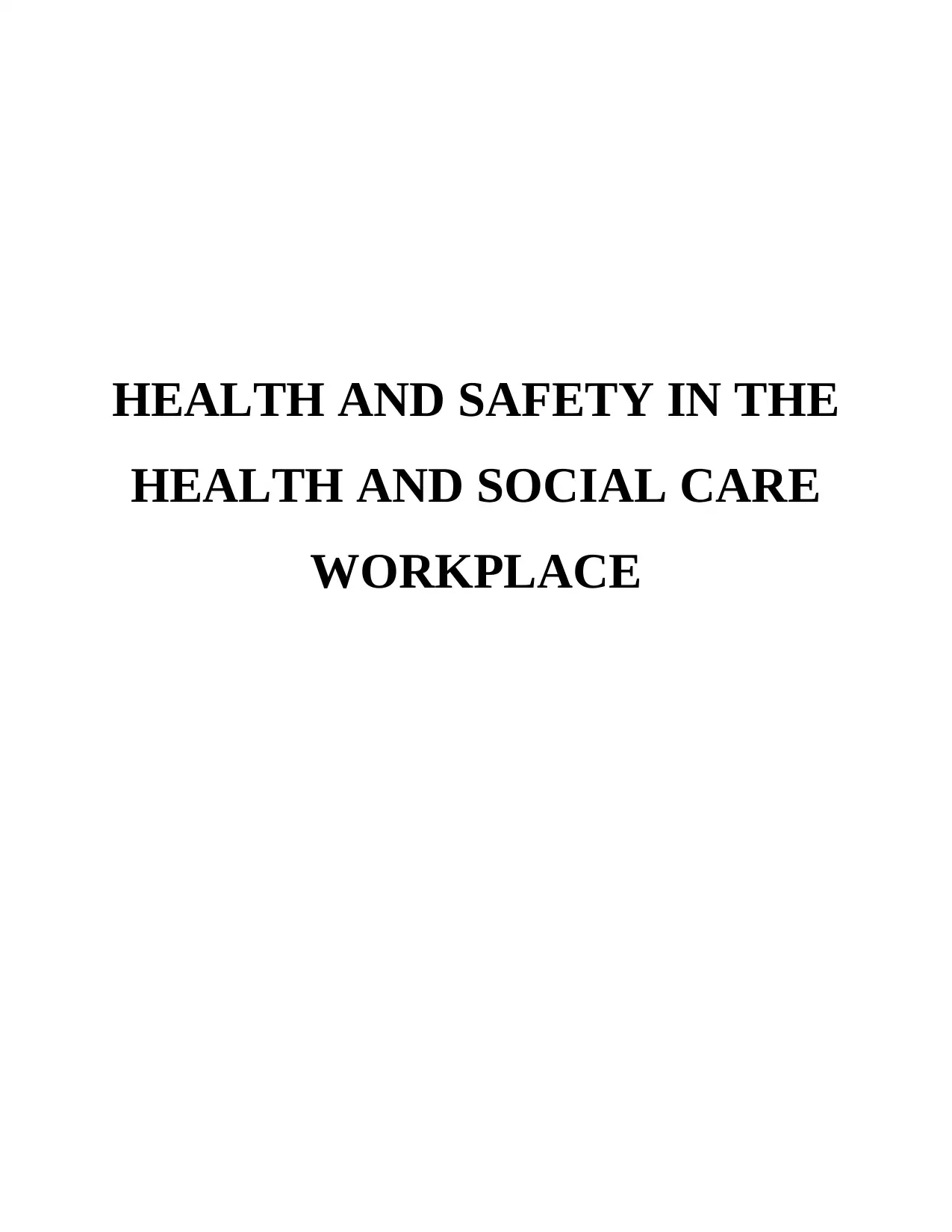
HEALTH AND SAFETY IN THE
HEALTH AND SOCIAL CARE
WORKPLACE
HEALTH AND SOCIAL CARE
WORKPLACE
Secure Best Marks with AI Grader
Need help grading? Try our AI Grader for instant feedback on your assignments.
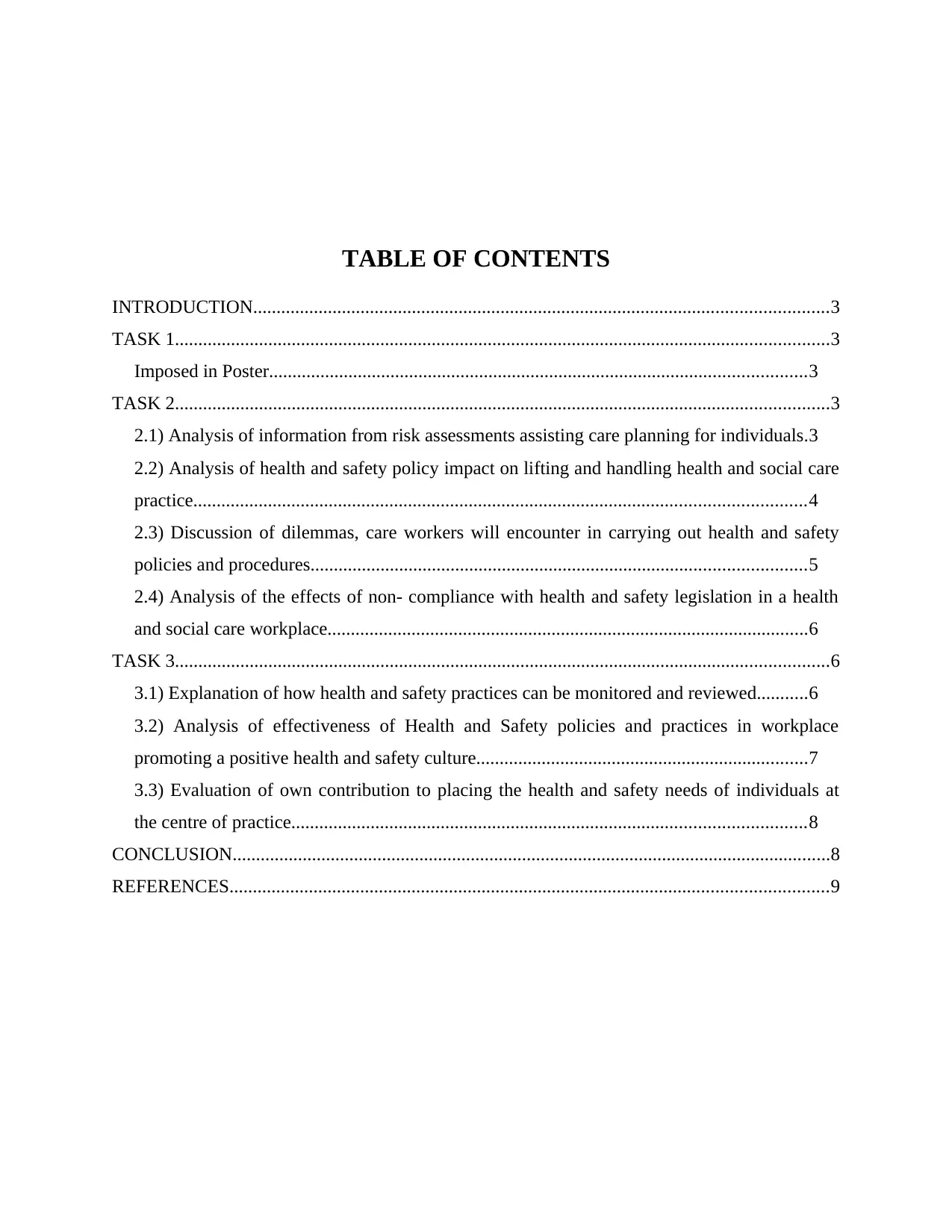
TABLE OF CONTENTS
INTRODUCTION...........................................................................................................................3
TASK 1............................................................................................................................................3
Imposed in Poster...................................................................................................................3
TASK 2............................................................................................................................................3
2.1) Analysis of information from risk assessments assisting care planning for individuals.3
2.2) Analysis of health and safety policy impact on lifting and handling health and social care
practice...................................................................................................................................4
2.3) Discussion of dilemmas, care workers will encounter in carrying out health and safety
policies and procedures..........................................................................................................5
2.4) Analysis of the effects of non- compliance with health and safety legislation in a health
and social care workplace.......................................................................................................6
TASK 3............................................................................................................................................6
3.1) Explanation of how health and safety practices can be monitored and reviewed...........6
3.2) Analysis of effectiveness of Health and Safety policies and practices in workplace
promoting a positive health and safety culture.......................................................................7
3.3) Evaluation of own contribution to placing the health and safety needs of individuals at
the centre of practice..............................................................................................................8
CONCLUSION................................................................................................................................8
REFERENCES................................................................................................................................9
INTRODUCTION...........................................................................................................................3
TASK 1............................................................................................................................................3
Imposed in Poster...................................................................................................................3
TASK 2............................................................................................................................................3
2.1) Analysis of information from risk assessments assisting care planning for individuals.3
2.2) Analysis of health and safety policy impact on lifting and handling health and social care
practice...................................................................................................................................4
2.3) Discussion of dilemmas, care workers will encounter in carrying out health and safety
policies and procedures..........................................................................................................5
2.4) Analysis of the effects of non- compliance with health and safety legislation in a health
and social care workplace.......................................................................................................6
TASK 3............................................................................................................................................6
3.1) Explanation of how health and safety practices can be monitored and reviewed...........6
3.2) Analysis of effectiveness of Health and Safety policies and practices in workplace
promoting a positive health and safety culture.......................................................................7
3.3) Evaluation of own contribution to placing the health and safety needs of individuals at
the centre of practice..............................................................................................................8
CONCLUSION................................................................................................................................8
REFERENCES................................................................................................................................9
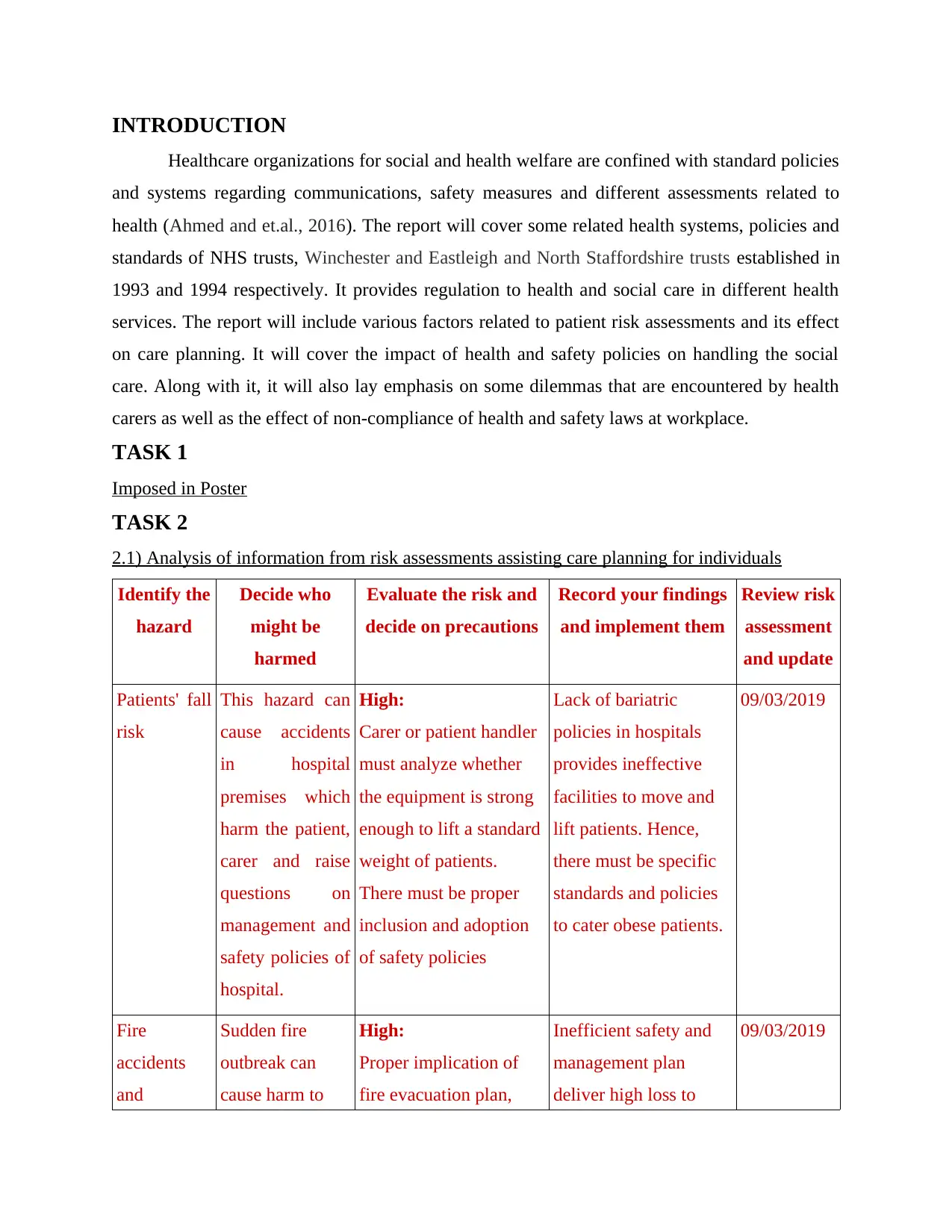
INTRODUCTION
Healthcare organizations for social and health welfare are confined with standard policies
and systems regarding communications, safety measures and different assessments related to
health (Ahmed and et.al., 2016). The report will cover some related health systems, policies and
standards of NHS trusts, Winchester and Eastleigh and North Staffordshire trusts established in
1993 and 1994 respectively. It provides regulation to health and social care in different health
services. The report will include various factors related to patient risk assessments and its effect
on care planning. It will cover the impact of health and safety policies on handling the social
care. Along with it, it will also lay emphasis on some dilemmas that are encountered by health
carers as well as the effect of non-compliance of health and safety laws at workplace.
TASK 1
Imposed in Poster
TASK 2
2.1) Analysis of information from risk assessments assisting care planning for individuals
Identify the
hazard
Decide who
might be
harmed
Evaluate the risk and
decide on precautions
Record your findings
and implement them
Review risk
assessment
and update
Patients' fall
risk
This hazard can
cause accidents
in hospital
premises which
harm the patient,
carer and raise
questions on
management and
safety policies of
hospital.
High:
Carer or patient handler
must analyze whether
the equipment is strong
enough to lift a standard
weight of patients.
There must be proper
inclusion and adoption
of safety policies
Lack of bariatric
policies in hospitals
provides ineffective
facilities to move and
lift patients. Hence,
there must be specific
standards and policies
to cater obese patients.
09/03/2019
Fire
accidents
and
Sudden fire
outbreak can
cause harm to
High:
Proper implication of
fire evacuation plan,
Inefficient safety and
management plan
deliver high loss to
09/03/2019
Healthcare organizations for social and health welfare are confined with standard policies
and systems regarding communications, safety measures and different assessments related to
health (Ahmed and et.al., 2016). The report will cover some related health systems, policies and
standards of NHS trusts, Winchester and Eastleigh and North Staffordshire trusts established in
1993 and 1994 respectively. It provides regulation to health and social care in different health
services. The report will include various factors related to patient risk assessments and its effect
on care planning. It will cover the impact of health and safety policies on handling the social
care. Along with it, it will also lay emphasis on some dilemmas that are encountered by health
carers as well as the effect of non-compliance of health and safety laws at workplace.
TASK 1
Imposed in Poster
TASK 2
2.1) Analysis of information from risk assessments assisting care planning for individuals
Identify the
hazard
Decide who
might be
harmed
Evaluate the risk and
decide on precautions
Record your findings
and implement them
Review risk
assessment
and update
Patients' fall
risk
This hazard can
cause accidents
in hospital
premises which
harm the patient,
carer and raise
questions on
management and
safety policies of
hospital.
High:
Carer or patient handler
must analyze whether
the equipment is strong
enough to lift a standard
weight of patients.
There must be proper
inclusion and adoption
of safety policies
Lack of bariatric
policies in hospitals
provides ineffective
facilities to move and
lift patients. Hence,
there must be specific
standards and policies
to cater obese patients.
09/03/2019
Fire
accidents
and
Sudden fire
outbreak can
cause harm to
High:
Proper implication of
fire evacuation plan,
Inefficient safety and
management plan
deliver high loss to
09/03/2019
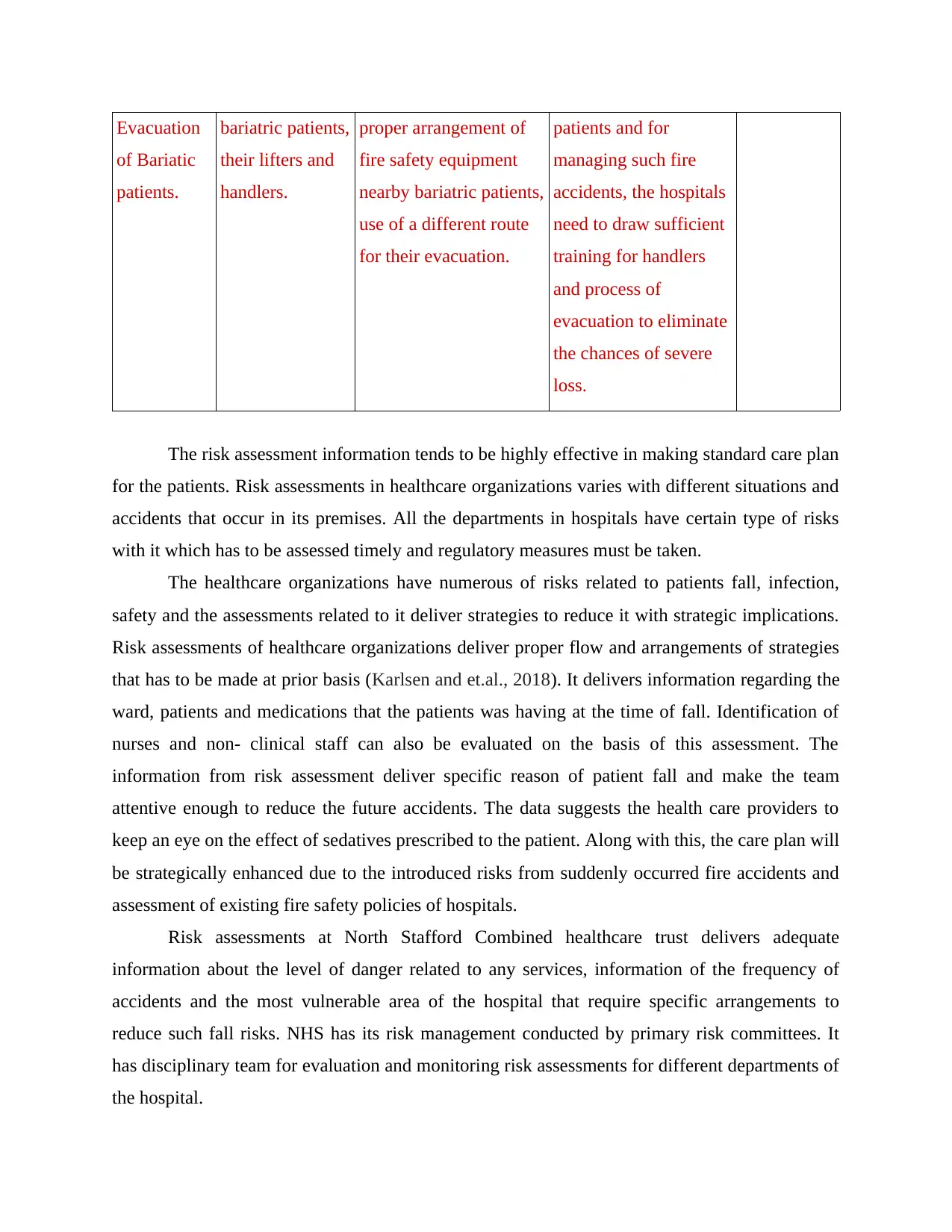
Evacuation
of Bariatic
patients.
bariatric patients,
their lifters and
handlers.
proper arrangement of
fire safety equipment
nearby bariatric patients,
use of a different route
for their evacuation.
patients and for
managing such fire
accidents, the hospitals
need to draw sufficient
training for handlers
and process of
evacuation to eliminate
the chances of severe
loss.
The risk assessment information tends to be highly effective in making standard care plan
for the patients. Risk assessments in healthcare organizations varies with different situations and
accidents that occur in its premises. All the departments in hospitals have certain type of risks
with it which has to be assessed timely and regulatory measures must be taken.
The healthcare organizations have numerous of risks related to patients fall, infection,
safety and the assessments related to it deliver strategies to reduce it with strategic implications.
Risk assessments of healthcare organizations deliver proper flow and arrangements of strategies
that has to be made at prior basis (Karlsen and et.al., 2018). It delivers information regarding the
ward, patients and medications that the patients was having at the time of fall. Identification of
nurses and non- clinical staff can also be evaluated on the basis of this assessment. The
information from risk assessment deliver specific reason of patient fall and make the team
attentive enough to reduce the future accidents. The data suggests the health care providers to
keep an eye on the effect of sedatives prescribed to the patient. Along with this, the care plan will
be strategically enhanced due to the introduced risks from suddenly occurred fire accidents and
assessment of existing fire safety policies of hospitals.
Risk assessments at North Stafford Combined healthcare trust delivers adequate
information about the level of danger related to any services, information of the frequency of
accidents and the most vulnerable area of the hospital that require specific arrangements to
reduce such fall risks. NHS has its risk management conducted by primary risk committees. It
has disciplinary team for evaluation and monitoring risk assessments for different departments of
the hospital.
of Bariatic
patients.
bariatric patients,
their lifters and
handlers.
proper arrangement of
fire safety equipment
nearby bariatric patients,
use of a different route
for their evacuation.
patients and for
managing such fire
accidents, the hospitals
need to draw sufficient
training for handlers
and process of
evacuation to eliminate
the chances of severe
loss.
The risk assessment information tends to be highly effective in making standard care plan
for the patients. Risk assessments in healthcare organizations varies with different situations and
accidents that occur in its premises. All the departments in hospitals have certain type of risks
with it which has to be assessed timely and regulatory measures must be taken.
The healthcare organizations have numerous of risks related to patients fall, infection,
safety and the assessments related to it deliver strategies to reduce it with strategic implications.
Risk assessments of healthcare organizations deliver proper flow and arrangements of strategies
that has to be made at prior basis (Karlsen and et.al., 2018). It delivers information regarding the
ward, patients and medications that the patients was having at the time of fall. Identification of
nurses and non- clinical staff can also be evaluated on the basis of this assessment. The
information from risk assessment deliver specific reason of patient fall and make the team
attentive enough to reduce the future accidents. The data suggests the health care providers to
keep an eye on the effect of sedatives prescribed to the patient. Along with this, the care plan will
be strategically enhanced due to the introduced risks from suddenly occurred fire accidents and
assessment of existing fire safety policies of hospitals.
Risk assessments at North Stafford Combined healthcare trust delivers adequate
information about the level of danger related to any services, information of the frequency of
accidents and the most vulnerable area of the hospital that require specific arrangements to
reduce such fall risks. NHS has its risk management conducted by primary risk committees. It
has disciplinary team for evaluation and monitoring risk assessments for different departments of
the hospital.
Secure Best Marks with AI Grader
Need help grading? Try our AI Grader for instant feedback on your assignments.
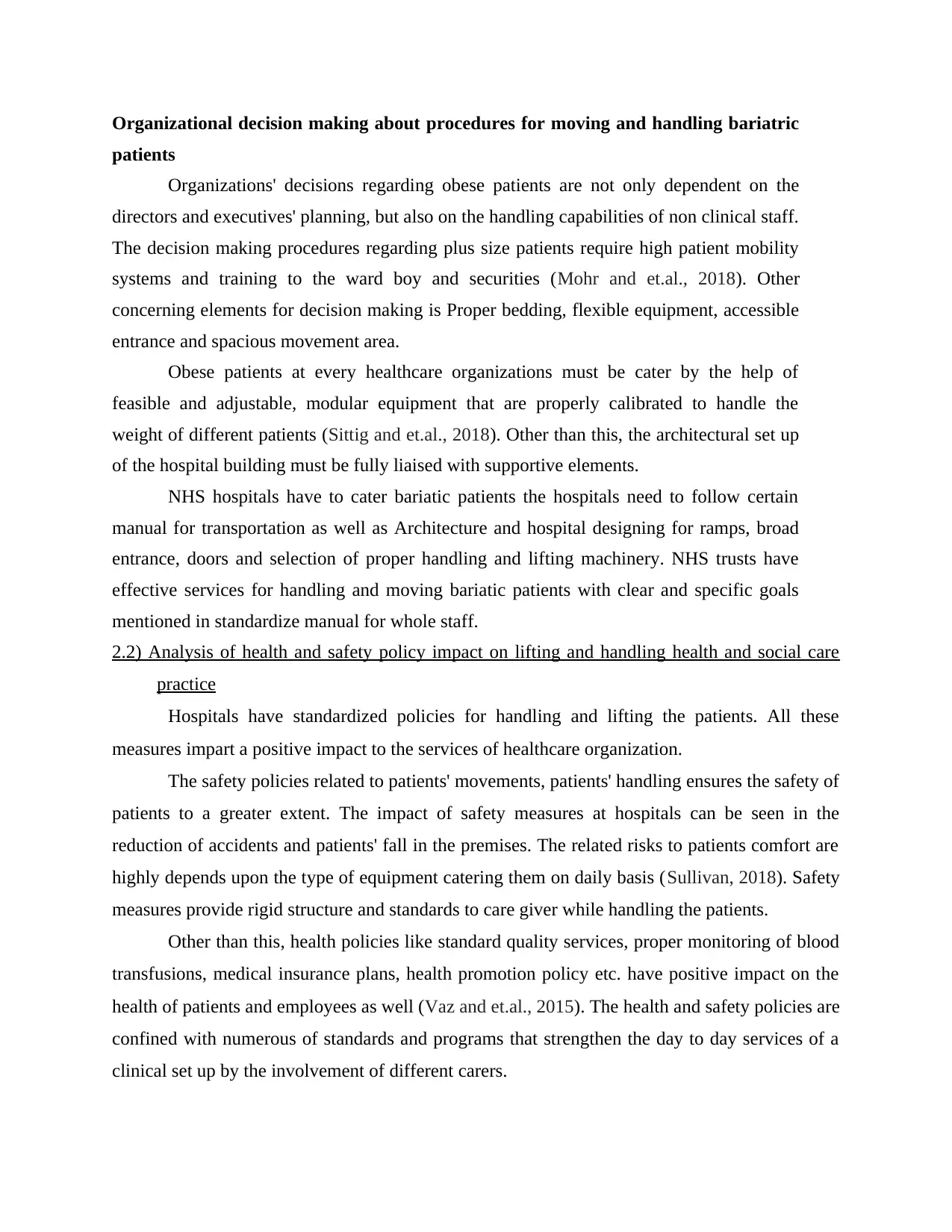
Organizational decision making about procedures for moving and handling bariatric
patients
Organizations' decisions regarding obese patients are not only dependent on the
directors and executives' planning, but also on the handling capabilities of non clinical staff.
The decision making procedures regarding plus size patients require high patient mobility
systems and training to the ward boy and securities (Mohr and et.al., 2018). Other
concerning elements for decision making is Proper bedding, flexible equipment, accessible
entrance and spacious movement area.
Obese patients at every healthcare organizations must be cater by the help of
feasible and adjustable, modular equipment that are properly calibrated to handle the
weight of different patients (Sittig and et.al., 2018). Other than this, the architectural set up
of the hospital building must be fully liaised with supportive elements.
NHS hospitals have to cater bariatic patients the hospitals need to follow certain
manual for transportation as well as Architecture and hospital designing for ramps, broad
entrance, doors and selection of proper handling and lifting machinery. NHS trusts have
effective services for handling and moving bariatic patients with clear and specific goals
mentioned in standardize manual for whole staff.
2.2) Analysis of health and safety policy impact on lifting and handling health and social care
practice
Hospitals have standardized policies for handling and lifting the patients. All these
measures impart a positive impact to the services of healthcare organization.
The safety policies related to patients' movements, patients' handling ensures the safety of
patients to a greater extent. The impact of safety measures at hospitals can be seen in the
reduction of accidents and patients' fall in the premises. The related risks to patients comfort are
highly depends upon the type of equipment catering them on daily basis (Sullivan, 2018). Safety
measures provide rigid structure and standards to care giver while handling the patients.
Other than this, health policies like standard quality services, proper monitoring of blood
transfusions, medical insurance plans, health promotion policy etc. have positive impact on the
health of patients and employees as well (Vaz and et.al., 2015). The health and safety policies are
confined with numerous of standards and programs that strengthen the day to day services of a
clinical set up by the involvement of different carers.
patients
Organizations' decisions regarding obese patients are not only dependent on the
directors and executives' planning, but also on the handling capabilities of non clinical staff.
The decision making procedures regarding plus size patients require high patient mobility
systems and training to the ward boy and securities (Mohr and et.al., 2018). Other
concerning elements for decision making is Proper bedding, flexible equipment, accessible
entrance and spacious movement area.
Obese patients at every healthcare organizations must be cater by the help of
feasible and adjustable, modular equipment that are properly calibrated to handle the
weight of different patients (Sittig and et.al., 2018). Other than this, the architectural set up
of the hospital building must be fully liaised with supportive elements.
NHS hospitals have to cater bariatic patients the hospitals need to follow certain
manual for transportation as well as Architecture and hospital designing for ramps, broad
entrance, doors and selection of proper handling and lifting machinery. NHS trusts have
effective services for handling and moving bariatic patients with clear and specific goals
mentioned in standardize manual for whole staff.
2.2) Analysis of health and safety policy impact on lifting and handling health and social care
practice
Hospitals have standardized policies for handling and lifting the patients. All these
measures impart a positive impact to the services of healthcare organization.
The safety policies related to patients' movements, patients' handling ensures the safety of
patients to a greater extent. The impact of safety measures at hospitals can be seen in the
reduction of accidents and patients' fall in the premises. The related risks to patients comfort are
highly depends upon the type of equipment catering them on daily basis (Sullivan, 2018). Safety
measures provide rigid structure and standards to care giver while handling the patients.
Other than this, health policies like standard quality services, proper monitoring of blood
transfusions, medical insurance plans, health promotion policy etc. have positive impact on the
health of patients and employees as well (Vaz and et.al., 2015). The health and safety policies are
confined with numerous of standards and programs that strengthen the day to day services of a
clinical set up by the involvement of different carers.
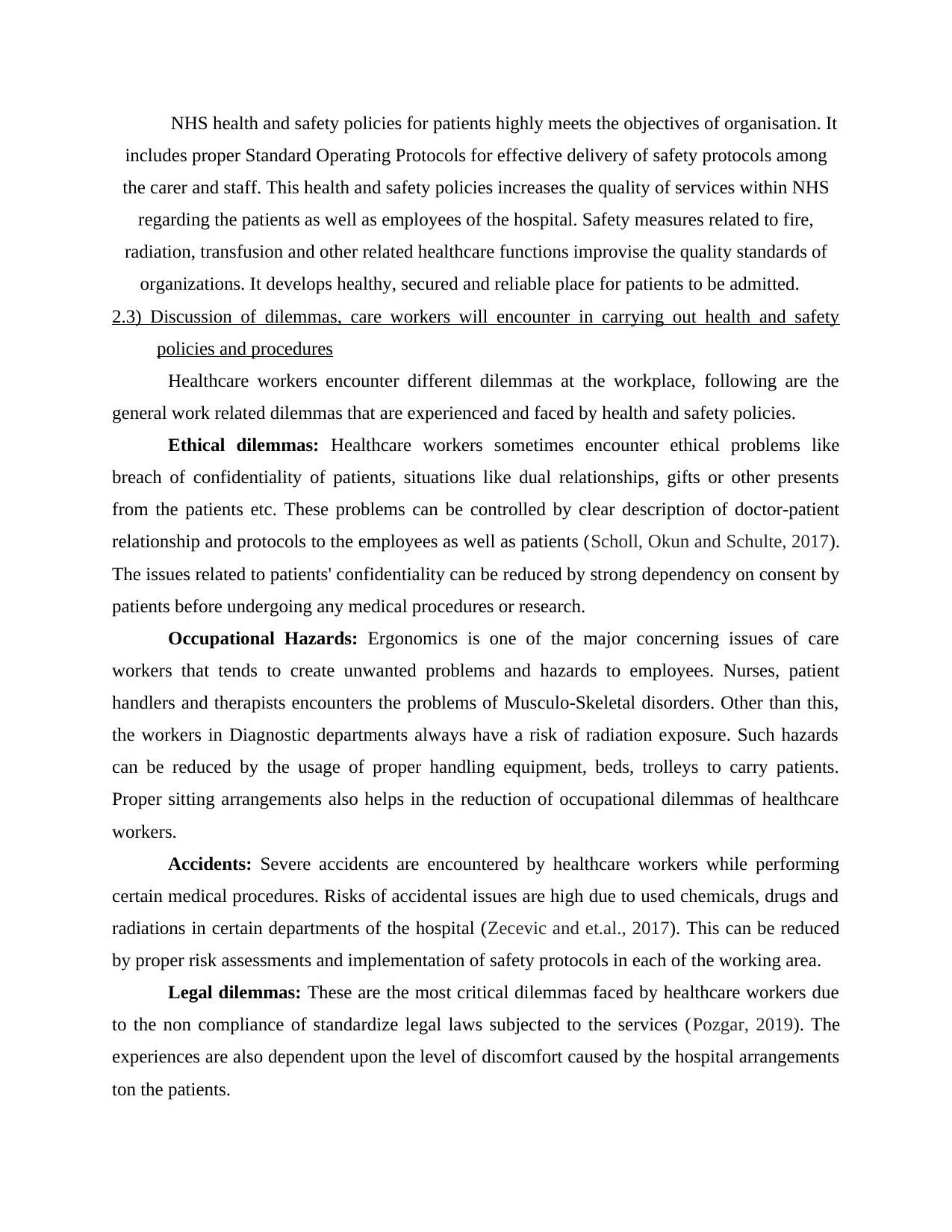
NHS health and safety policies for patients highly meets the objectives of organisation. It
includes proper Standard Operating Protocols for effective delivery of safety protocols among
the carer and staff. This health and safety policies increases the quality of services within NHS
regarding the patients as well as employees of the hospital. Safety measures related to fire,
radiation, transfusion and other related healthcare functions improvise the quality standards of
organizations. It develops healthy, secured and reliable place for patients to be admitted.
2.3) Discussion of dilemmas, care workers will encounter in carrying out health and safety
policies and procedures
Healthcare workers encounter different dilemmas at the workplace, following are the
general work related dilemmas that are experienced and faced by health and safety policies.
Ethical dilemmas: Healthcare workers sometimes encounter ethical problems like
breach of confidentiality of patients, situations like dual relationships, gifts or other presents
from the patients etc. These problems can be controlled by clear description of doctor-patient
relationship and protocols to the employees as well as patients (Scholl, Okun and Schulte, 2017).
The issues related to patients' confidentiality can be reduced by strong dependency on consent by
patients before undergoing any medical procedures or research.
Occupational Hazards: Ergonomics is one of the major concerning issues of care
workers that tends to create unwanted problems and hazards to employees. Nurses, patient
handlers and therapists encounters the problems of Musculo-Skeletal disorders. Other than this,
the workers in Diagnostic departments always have a risk of radiation exposure. Such hazards
can be reduced by the usage of proper handling equipment, beds, trolleys to carry patients.
Proper sitting arrangements also helps in the reduction of occupational dilemmas of healthcare
workers.
Accidents: Severe accidents are encountered by healthcare workers while performing
certain medical procedures. Risks of accidental issues are high due to used chemicals, drugs and
radiations in certain departments of the hospital (Zecevic and et.al., 2017). This can be reduced
by proper risk assessments and implementation of safety protocols in each of the working area.
Legal dilemmas: These are the most critical dilemmas faced by healthcare workers due
to the non compliance of standardize legal laws subjected to the services (Pozgar, 2019). The
experiences are also dependent upon the level of discomfort caused by the hospital arrangements
ton the patients.
includes proper Standard Operating Protocols for effective delivery of safety protocols among
the carer and staff. This health and safety policies increases the quality of services within NHS
regarding the patients as well as employees of the hospital. Safety measures related to fire,
radiation, transfusion and other related healthcare functions improvise the quality standards of
organizations. It develops healthy, secured and reliable place for patients to be admitted.
2.3) Discussion of dilemmas, care workers will encounter in carrying out health and safety
policies and procedures
Healthcare workers encounter different dilemmas at the workplace, following are the
general work related dilemmas that are experienced and faced by health and safety policies.
Ethical dilemmas: Healthcare workers sometimes encounter ethical problems like
breach of confidentiality of patients, situations like dual relationships, gifts or other presents
from the patients etc. These problems can be controlled by clear description of doctor-patient
relationship and protocols to the employees as well as patients (Scholl, Okun and Schulte, 2017).
The issues related to patients' confidentiality can be reduced by strong dependency on consent by
patients before undergoing any medical procedures or research.
Occupational Hazards: Ergonomics is one of the major concerning issues of care
workers that tends to create unwanted problems and hazards to employees. Nurses, patient
handlers and therapists encounters the problems of Musculo-Skeletal disorders. Other than this,
the workers in Diagnostic departments always have a risk of radiation exposure. Such hazards
can be reduced by the usage of proper handling equipment, beds, trolleys to carry patients.
Proper sitting arrangements also helps in the reduction of occupational dilemmas of healthcare
workers.
Accidents: Severe accidents are encountered by healthcare workers while performing
certain medical procedures. Risks of accidental issues are high due to used chemicals, drugs and
radiations in certain departments of the hospital (Zecevic and et.al., 2017). This can be reduced
by proper risk assessments and implementation of safety protocols in each of the working area.
Legal dilemmas: These are the most critical dilemmas faced by healthcare workers due
to the non compliance of standardize legal laws subjected to the services (Pozgar, 2019). The
experiences are also dependent upon the level of discomfort caused by the hospital arrangements
ton the patients.
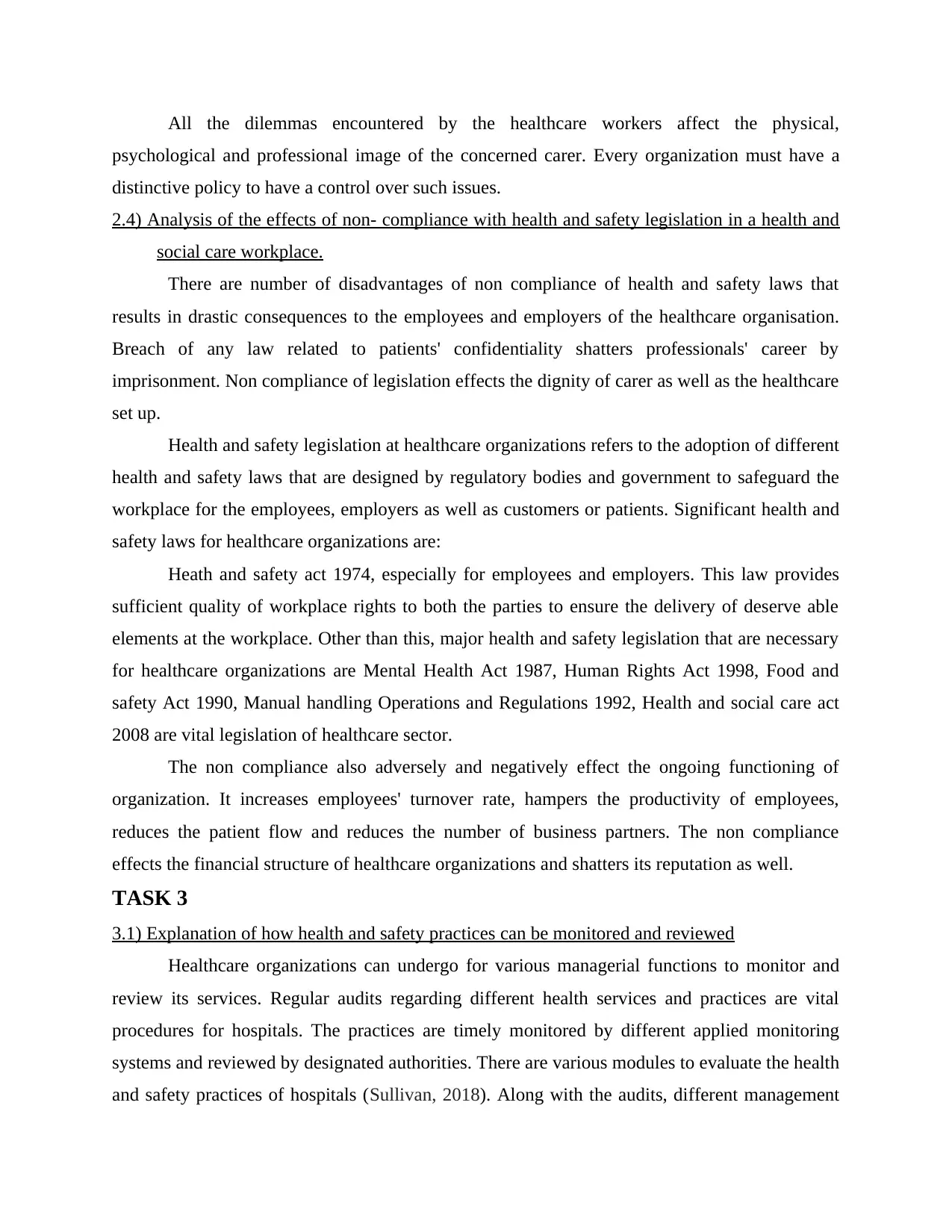
All the dilemmas encountered by the healthcare workers affect the physical,
psychological and professional image of the concerned carer. Every organization must have a
distinctive policy to have a control over such issues.
2.4) Analysis of the effects of non- compliance with health and safety legislation in a health and
social care workplace.
There are number of disadvantages of non compliance of health and safety laws that
results in drastic consequences to the employees and employers of the healthcare organisation.
Breach of any law related to patients' confidentiality shatters professionals' career by
imprisonment. Non compliance of legislation effects the dignity of carer as well as the healthcare
set up.
Health and safety legislation at healthcare organizations refers to the adoption of different
health and safety laws that are designed by regulatory bodies and government to safeguard the
workplace for the employees, employers as well as customers or patients. Significant health and
safety laws for healthcare organizations are:
Heath and safety act 1974, especially for employees and employers. This law provides
sufficient quality of workplace rights to both the parties to ensure the delivery of deserve able
elements at the workplace. Other than this, major health and safety legislation that are necessary
for healthcare organizations are Mental Health Act 1987, Human Rights Act 1998, Food and
safety Act 1990, Manual handling Operations and Regulations 1992, Health and social care act
2008 are vital legislation of healthcare sector.
The non compliance also adversely and negatively effect the ongoing functioning of
organization. It increases employees' turnover rate, hampers the productivity of employees,
reduces the patient flow and reduces the number of business partners. The non compliance
effects the financial structure of healthcare organizations and shatters its reputation as well.
TASK 3
3.1) Explanation of how health and safety practices can be monitored and reviewed
Healthcare organizations can undergo for various managerial functions to monitor and
review its services. Regular audits regarding different health services and practices are vital
procedures for hospitals. The practices are timely monitored by different applied monitoring
systems and reviewed by designated authorities. There are various modules to evaluate the health
and safety practices of hospitals (Sullivan, 2018). Along with the audits, different management
psychological and professional image of the concerned carer. Every organization must have a
distinctive policy to have a control over such issues.
2.4) Analysis of the effects of non- compliance with health and safety legislation in a health and
social care workplace.
There are number of disadvantages of non compliance of health and safety laws that
results in drastic consequences to the employees and employers of the healthcare organisation.
Breach of any law related to patients' confidentiality shatters professionals' career by
imprisonment. Non compliance of legislation effects the dignity of carer as well as the healthcare
set up.
Health and safety legislation at healthcare organizations refers to the adoption of different
health and safety laws that are designed by regulatory bodies and government to safeguard the
workplace for the employees, employers as well as customers or patients. Significant health and
safety laws for healthcare organizations are:
Heath and safety act 1974, especially for employees and employers. This law provides
sufficient quality of workplace rights to both the parties to ensure the delivery of deserve able
elements at the workplace. Other than this, major health and safety legislation that are necessary
for healthcare organizations are Mental Health Act 1987, Human Rights Act 1998, Food and
safety Act 1990, Manual handling Operations and Regulations 1992, Health and social care act
2008 are vital legislation of healthcare sector.
The non compliance also adversely and negatively effect the ongoing functioning of
organization. It increases employees' turnover rate, hampers the productivity of employees,
reduces the patient flow and reduces the number of business partners. The non compliance
effects the financial structure of healthcare organizations and shatters its reputation as well.
TASK 3
3.1) Explanation of how health and safety practices can be monitored and reviewed
Healthcare organizations can undergo for various managerial functions to monitor and
review its services. Regular audits regarding different health services and practices are vital
procedures for hospitals. The practices are timely monitored by different applied monitoring
systems and reviewed by designated authorities. There are various modules to evaluate the health
and safety practices of hospitals (Sullivan, 2018). Along with the audits, different management
Paraphrase This Document
Need a fresh take? Get an instant paraphrase of this document with our AI Paraphraser
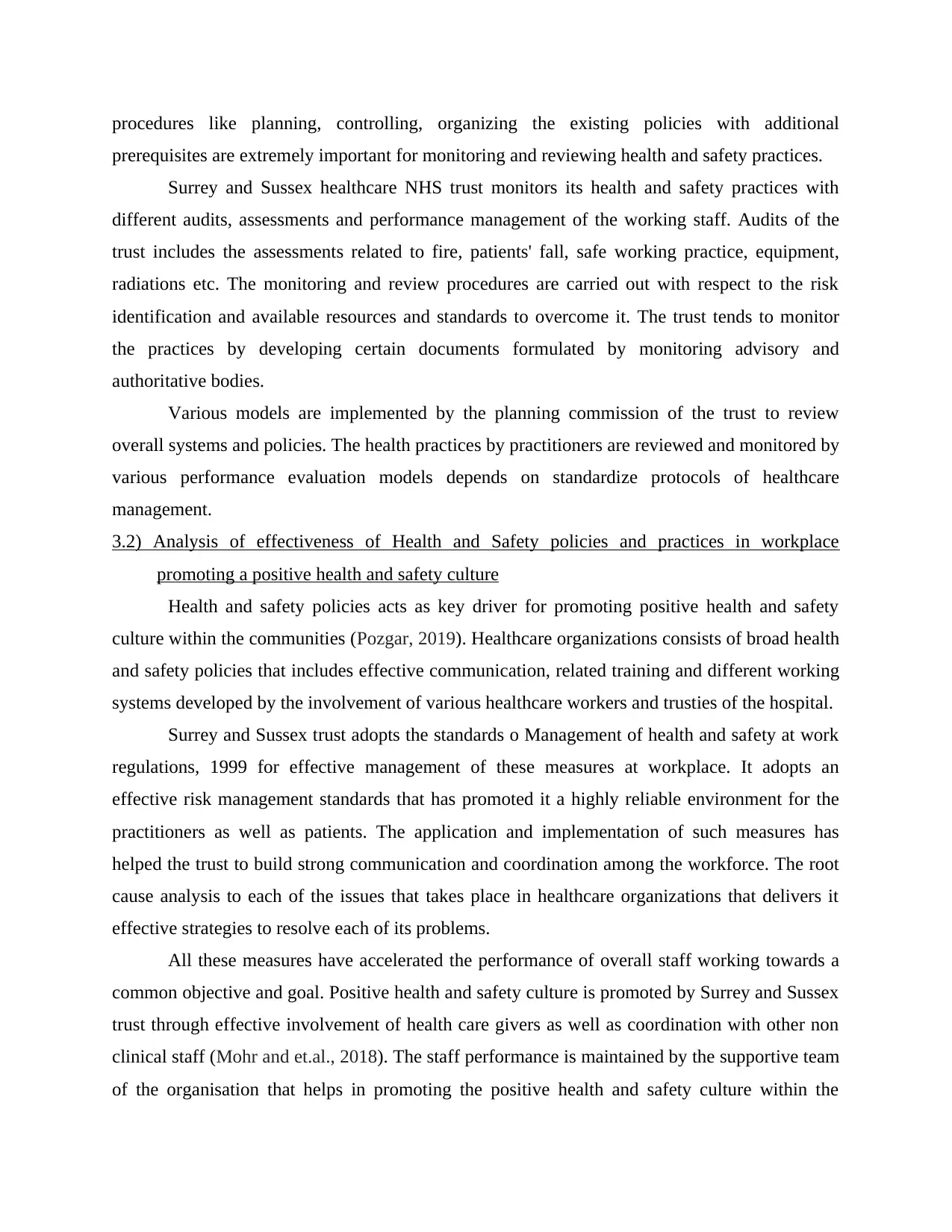
procedures like planning, controlling, organizing the existing policies with additional
prerequisites are extremely important for monitoring and reviewing health and safety practices.
Surrey and Sussex healthcare NHS trust monitors its health and safety practices with
different audits, assessments and performance management of the working staff. Audits of the
trust includes the assessments related to fire, patients' fall, safe working practice, equipment,
radiations etc. The monitoring and review procedures are carried out with respect to the risk
identification and available resources and standards to overcome it. The trust tends to monitor
the practices by developing certain documents formulated by monitoring advisory and
authoritative bodies.
Various models are implemented by the planning commission of the trust to review
overall systems and policies. The health practices by practitioners are reviewed and monitored by
various performance evaluation models depends on standardize protocols of healthcare
management.
3.2) Analysis of effectiveness of Health and Safety policies and practices in workplace
promoting a positive health and safety culture
Health and safety policies acts as key driver for promoting positive health and safety
culture within the communities (Pozgar, 2019). Healthcare organizations consists of broad health
and safety policies that includes effective communication, related training and different working
systems developed by the involvement of various healthcare workers and trusties of the hospital.
Surrey and Sussex trust adopts the standards o Management of health and safety at work
regulations, 1999 for effective management of these measures at workplace. It adopts an
effective risk management standards that has promoted it a highly reliable environment for the
practitioners as well as patients. The application and implementation of such measures has
helped the trust to build strong communication and coordination among the workforce. The root
cause analysis to each of the issues that takes place in healthcare organizations that delivers it
effective strategies to resolve each of its problems.
All these measures have accelerated the performance of overall staff working towards a
common objective and goal. Positive health and safety culture is promoted by Surrey and Sussex
trust through effective involvement of health care givers as well as coordination with other non
clinical staff (Mohr and et.al., 2018). The staff performance is maintained by the supportive team
of the organisation that helps in promoting the positive health and safety culture within the
prerequisites are extremely important for monitoring and reviewing health and safety practices.
Surrey and Sussex healthcare NHS trust monitors its health and safety practices with
different audits, assessments and performance management of the working staff. Audits of the
trust includes the assessments related to fire, patients' fall, safe working practice, equipment,
radiations etc. The monitoring and review procedures are carried out with respect to the risk
identification and available resources and standards to overcome it. The trust tends to monitor
the practices by developing certain documents formulated by monitoring advisory and
authoritative bodies.
Various models are implemented by the planning commission of the trust to review
overall systems and policies. The health practices by practitioners are reviewed and monitored by
various performance evaluation models depends on standardize protocols of healthcare
management.
3.2) Analysis of effectiveness of Health and Safety policies and practices in workplace
promoting a positive health and safety culture
Health and safety policies acts as key driver for promoting positive health and safety
culture within the communities (Pozgar, 2019). Healthcare organizations consists of broad health
and safety policies that includes effective communication, related training and different working
systems developed by the involvement of various healthcare workers and trusties of the hospital.
Surrey and Sussex trust adopts the standards o Management of health and safety at work
regulations, 1999 for effective management of these measures at workplace. It adopts an
effective risk management standards that has promoted it a highly reliable environment for the
practitioners as well as patients. The application and implementation of such measures has
helped the trust to build strong communication and coordination among the workforce. The root
cause analysis to each of the issues that takes place in healthcare organizations that delivers it
effective strategies to resolve each of its problems.
All these measures have accelerated the performance of overall staff working towards a
common objective and goal. Positive health and safety culture is promoted by Surrey and Sussex
trust through effective involvement of health care givers as well as coordination with other non
clinical staff (Mohr and et.al., 2018). The staff performance is maintained by the supportive team
of the organisation that helps in promoting the positive health and safety culture within the
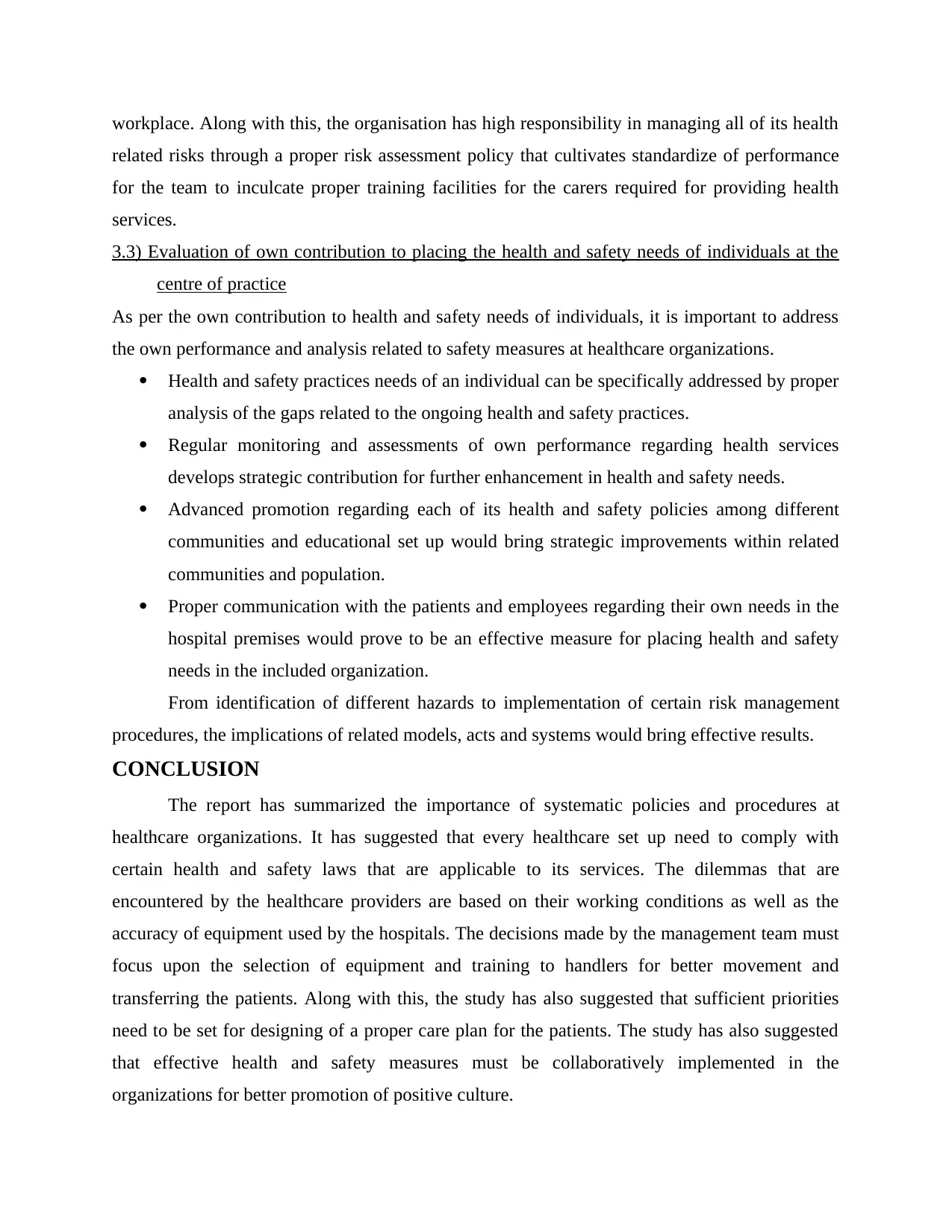
workplace. Along with this, the organisation has high responsibility in managing all of its health
related risks through a proper risk assessment policy that cultivates standardize of performance
for the team to inculcate proper training facilities for the carers required for providing health
services.
3.3) Evaluation of own contribution to placing the health and safety needs of individuals at the
centre of practice
As per the own contribution to health and safety needs of individuals, it is important to address
the own performance and analysis related to safety measures at healthcare organizations.
Health and safety practices needs of an individual can be specifically addressed by proper
analysis of the gaps related to the ongoing health and safety practices.
Regular monitoring and assessments of own performance regarding health services
develops strategic contribution for further enhancement in health and safety needs.
Advanced promotion regarding each of its health and safety policies among different
communities and educational set up would bring strategic improvements within related
communities and population.
Proper communication with the patients and employees regarding their own needs in the
hospital premises would prove to be an effective measure for placing health and safety
needs in the included organization.
From identification of different hazards to implementation of certain risk management
procedures, the implications of related models, acts and systems would bring effective results.
CONCLUSION
The report has summarized the importance of systematic policies and procedures at
healthcare organizations. It has suggested that every healthcare set up need to comply with
certain health and safety laws that are applicable to its services. The dilemmas that are
encountered by the healthcare providers are based on their working conditions as well as the
accuracy of equipment used by the hospitals. The decisions made by the management team must
focus upon the selection of equipment and training to handlers for better movement and
transferring the patients. Along with this, the study has also suggested that sufficient priorities
need to be set for designing of a proper care plan for the patients. The study has also suggested
that effective health and safety measures must be collaboratively implemented in the
organizations for better promotion of positive culture.
related risks through a proper risk assessment policy that cultivates standardize of performance
for the team to inculcate proper training facilities for the carers required for providing health
services.
3.3) Evaluation of own contribution to placing the health and safety needs of individuals at the
centre of practice
As per the own contribution to health and safety needs of individuals, it is important to address
the own performance and analysis related to safety measures at healthcare organizations.
Health and safety practices needs of an individual can be specifically addressed by proper
analysis of the gaps related to the ongoing health and safety practices.
Regular monitoring and assessments of own performance regarding health services
develops strategic contribution for further enhancement in health and safety needs.
Advanced promotion regarding each of its health and safety policies among different
communities and educational set up would bring strategic improvements within related
communities and population.
Proper communication with the patients and employees regarding their own needs in the
hospital premises would prove to be an effective measure for placing health and safety
needs in the included organization.
From identification of different hazards to implementation of certain risk management
procedures, the implications of related models, acts and systems would bring effective results.
CONCLUSION
The report has summarized the importance of systematic policies and procedures at
healthcare organizations. It has suggested that every healthcare set up need to comply with
certain health and safety laws that are applicable to its services. The dilemmas that are
encountered by the healthcare providers are based on their working conditions as well as the
accuracy of equipment used by the hospitals. The decisions made by the management team must
focus upon the selection of equipment and training to handlers for better movement and
transferring the patients. Along with this, the study has also suggested that sufficient priorities
need to be set for designing of a proper care plan for the patients. The study has also suggested
that effective health and safety measures must be collaboratively implemented in the
organizations for better promotion of positive culture.

REFERENCES
Books and Journals
Books and Journals
Secure Best Marks with AI Grader
Need help grading? Try our AI Grader for instant feedback on your assignments.
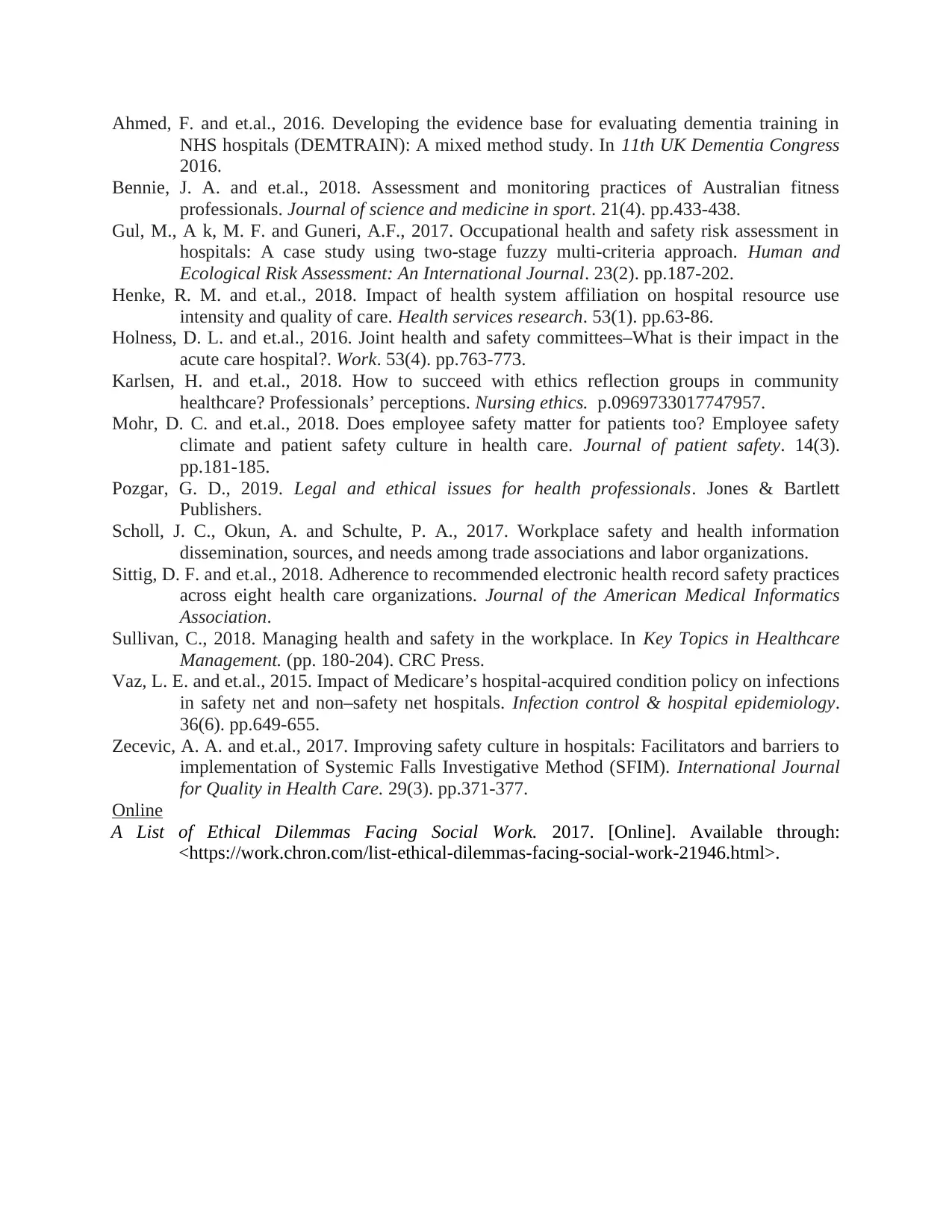
Ahmed, F. and et.al., 2016. Developing the evidence base for evaluating dementia training in
NHS hospitals (DEMTRAIN): A mixed method study. In 11th UK Dementia Congress
2016.
Bennie, J. A. and et.al., 2018. Assessment and monitoring practices of Australian fitness
professionals. Journal of science and medicine in sport. 21(4). pp.433-438.
Gul, M., A k, M. F. and Guneri, A.F., 2017. Occupational health and safety risk assessment in
hospitals: A case study using two-stage fuzzy multi-criteria approach. Human and
Ecological Risk Assessment: An International Journal. 23(2). pp.187-202.
Henke, R. M. and et.al., 2018. Impact of health system affiliation on hospital resource use
intensity and quality of care. Health services research. 53(1). pp.63-86.
Holness, D. L. and et.al., 2016. Joint health and safety committees–What is their impact in the
acute care hospital?. Work. 53(4). pp.763-773.
Karlsen, H. and et.al., 2018. How to succeed with ethics reflection groups in community
healthcare? Professionals’ perceptions. Nursing ethics. p.0969733017747957.
Mohr, D. C. and et.al., 2018. Does employee safety matter for patients too? Employee safety
climate and patient safety culture in health care. Journal of patient safety. 14(3).
pp.181-185.
Pozgar, G. D., 2019. Legal and ethical issues for health professionals. Jones & Bartlett
Publishers.
Scholl, J. C., Okun, A. and Schulte, P. A., 2017. Workplace safety and health information
dissemination, sources, and needs among trade associations and labor organizations.
Sittig, D. F. and et.al., 2018. Adherence to recommended electronic health record safety practices
across eight health care organizations. Journal of the American Medical Informatics
Association.
Sullivan, C., 2018. Managing health and safety in the workplace. In Key Topics in Healthcare
Management. (pp. 180-204). CRC Press.
Vaz, L. E. and et.al., 2015. Impact of Medicare’s hospital-acquired condition policy on infections
in safety net and non–safety net hospitals. Infection control & hospital epidemiology.
36(6). pp.649-655.
Zecevic, A. A. and et.al., 2017. Improving safety culture in hospitals: Facilitators and barriers to
implementation of Systemic Falls Investigative Method (SFIM). International Journal
for Quality in Health Care. 29(3). pp.371-377.
Online
A List of Ethical Dilemmas Facing Social Work. 2017. [Online]. Available through:
<https://work.chron.com/list-ethical-dilemmas-facing-social-work-21946.html>.
NHS hospitals (DEMTRAIN): A mixed method study. In 11th UK Dementia Congress
2016.
Bennie, J. A. and et.al., 2018. Assessment and monitoring practices of Australian fitness
professionals. Journal of science and medicine in sport. 21(4). pp.433-438.
Gul, M., A k, M. F. and Guneri, A.F., 2017. Occupational health and safety risk assessment in
hospitals: A case study using two-stage fuzzy multi-criteria approach. Human and
Ecological Risk Assessment: An International Journal. 23(2). pp.187-202.
Henke, R. M. and et.al., 2018. Impact of health system affiliation on hospital resource use
intensity and quality of care. Health services research. 53(1). pp.63-86.
Holness, D. L. and et.al., 2016. Joint health and safety committees–What is their impact in the
acute care hospital?. Work. 53(4). pp.763-773.
Karlsen, H. and et.al., 2018. How to succeed with ethics reflection groups in community
healthcare? Professionals’ perceptions. Nursing ethics. p.0969733017747957.
Mohr, D. C. and et.al., 2018. Does employee safety matter for patients too? Employee safety
climate and patient safety culture in health care. Journal of patient safety. 14(3).
pp.181-185.
Pozgar, G. D., 2019. Legal and ethical issues for health professionals. Jones & Bartlett
Publishers.
Scholl, J. C., Okun, A. and Schulte, P. A., 2017. Workplace safety and health information
dissemination, sources, and needs among trade associations and labor organizations.
Sittig, D. F. and et.al., 2018. Adherence to recommended electronic health record safety practices
across eight health care organizations. Journal of the American Medical Informatics
Association.
Sullivan, C., 2018. Managing health and safety in the workplace. In Key Topics in Healthcare
Management. (pp. 180-204). CRC Press.
Vaz, L. E. and et.al., 2015. Impact of Medicare’s hospital-acquired condition policy on infections
in safety net and non–safety net hospitals. Infection control & hospital epidemiology.
36(6). pp.649-655.
Zecevic, A. A. and et.al., 2017. Improving safety culture in hospitals: Facilitators and barriers to
implementation of Systemic Falls Investigative Method (SFIM). International Journal
for Quality in Health Care. 29(3). pp.371-377.
Online
A List of Ethical Dilemmas Facing Social Work. 2017. [Online]. Available through:
<https://work.chron.com/list-ethical-dilemmas-facing-social-work-21946.html>.
1 out of 11
Related Documents
Your All-in-One AI-Powered Toolkit for Academic Success.
+13062052269
info@desklib.com
Available 24*7 on WhatsApp / Email
![[object Object]](/_next/static/media/star-bottom.7253800d.svg)
Unlock your academic potential
© 2024 | Zucol Services PVT LTD | All rights reserved.





